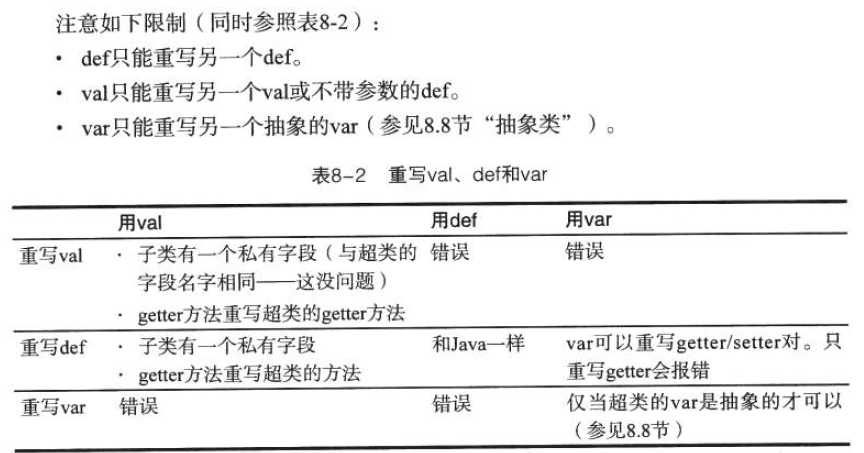标签:
class Persion{ def display(){ println("Hello") } final def display1(){ //声明为final, 不能被重写 override println("Hello1") } } class Employee extends Persion{ //extends 扩展,继承Persion override def display() { //override重写 display方法 println("H") } } val p = new Employee p.display() p.display1()
class Persion{ private var str = "" def display(){ println("Hello") } final def display1(){ //声明为final, 不能被重写 override println("Hello1") } def info_= (newStr:String){ //info setter方法 str = newStr } def info = str //info getter方法 } class Employee extends Persion{ //extends 扩展,继承Persion override def display() { //override重写 display方法 println(super.info +" H") } } val p = new Employee p.info="hello" p.display() p.display1()
调用超类的方法使用: super
class Persion{ } val p = new Persion if(p.isInstanceOf[Persion]){ //类型检查 println("p is instance of Persion") } else{ println("p is not instance of Persion") } if(p.getClass == classOf[Persion]){ //p是 Persion对象,并不是Persion的子类,这样检查 println("Yes") }
protected 可以被子类访问
传递到超类的构造函数
class Employee(name: String, age: Int, val salary: Double) extends Persion(name, age)
Scala类可以扩展java类
class Square(x:Int , y: Int, width: Int) extends java.awt.Rectangle(x, y, width, width)
class Persion(val name: String){ override def toString = getClass.getName()+ "[name="+name+"]" } class SecretAgent (codename: String) extends Persion(codename){ override val name = "secret" //重写 name override val toString ="secret" //重写 toString } val p = new SecretAgent("hello") println(p.name) println(p.toString)
常用做法:用val重写抽象的def
abstract class Persion{ def id :Int = 10 } class Student(override val id:Int) extends Persion{ } val p = new Student(4) println(p.id)

class Persion(val name:String){ } val alien = new Persion("Fred"){ //匿名子类 类型为 Persion{def greeting: String} def greeting = "Hi everybody" } def meet(p:Persion{def greeting: String}){ println(p.name + " says:" + p.greeting) } meet(alien)
结果:
Fred says:Hi everybody
abstract class Persion(val name:String){ //抽象类 def id:Int //方法不用定义为抽象 } class Student(name:String) extends Persion(name){ //继承抽象类 def id = name.hashCode //实现抽象类中的方法, 不需要override关键字 } val s = new Student("Jim") println(s.id)
abstract class Persion{ val id :Int var name : String } class Student(val id :Int) extends Persion{ var name ="" } val fred = new Persion{ val id = 12 var name = "Fred" } println(fred.id) println(fred.name)
结果:
12
Fred
class Creature { val range: Int = 10 val env: Array[Int] = new Array[Int](range) } class Ant extends Creature{ override val range: Int = 2 } val c = new Ant println(c.range) //结果为2 println(c.env.length) //结果为0
class Creature { lazy val range: Int = 10 //使用lazy val env: Array[Int] = new Array[Int](range) } class Ant extends Creature{ override lazy val range: Int = 2 //使用lazy } val c = new Ant println(c.range) println(c.env.length) //返回结果为2
class Creature { val range: Int = 10 val env: Array[Int] = new Array[Int](range) } class Ant extends { //使用提前定义 with Creature override val range: Int = 2 }with Creature val c = new Ant println(c.range) println(c.env.length) //结果返回2

Any 类继承层次根节点
Nothing 类型没有实例
Null 类型的唯一实例是null值
Nil 空列表, 空列表的类型是List[Nothing]
Unit 类型void
class Item(val desc: String, val value: Double){ final override def equals(other: Any) ={ //参数使用 Any类型 ,重写AnyRef equals方法 val that = other.asInstanceOf[Item] if(that == null) false else desc == that.desc && value ==that.value //判断是否相等 } final override def hashCode = 13 * desc.hashCode + 17 * value.hashCode //重写 hashCode方法 } val a = new Item("Apple", 14) val b = new Item("Apple", 23) if(a == b) println("Equal")
参考《快学Scala》
标签:
原文地址:http://www.cnblogs.com/one--way/p/5806604.html